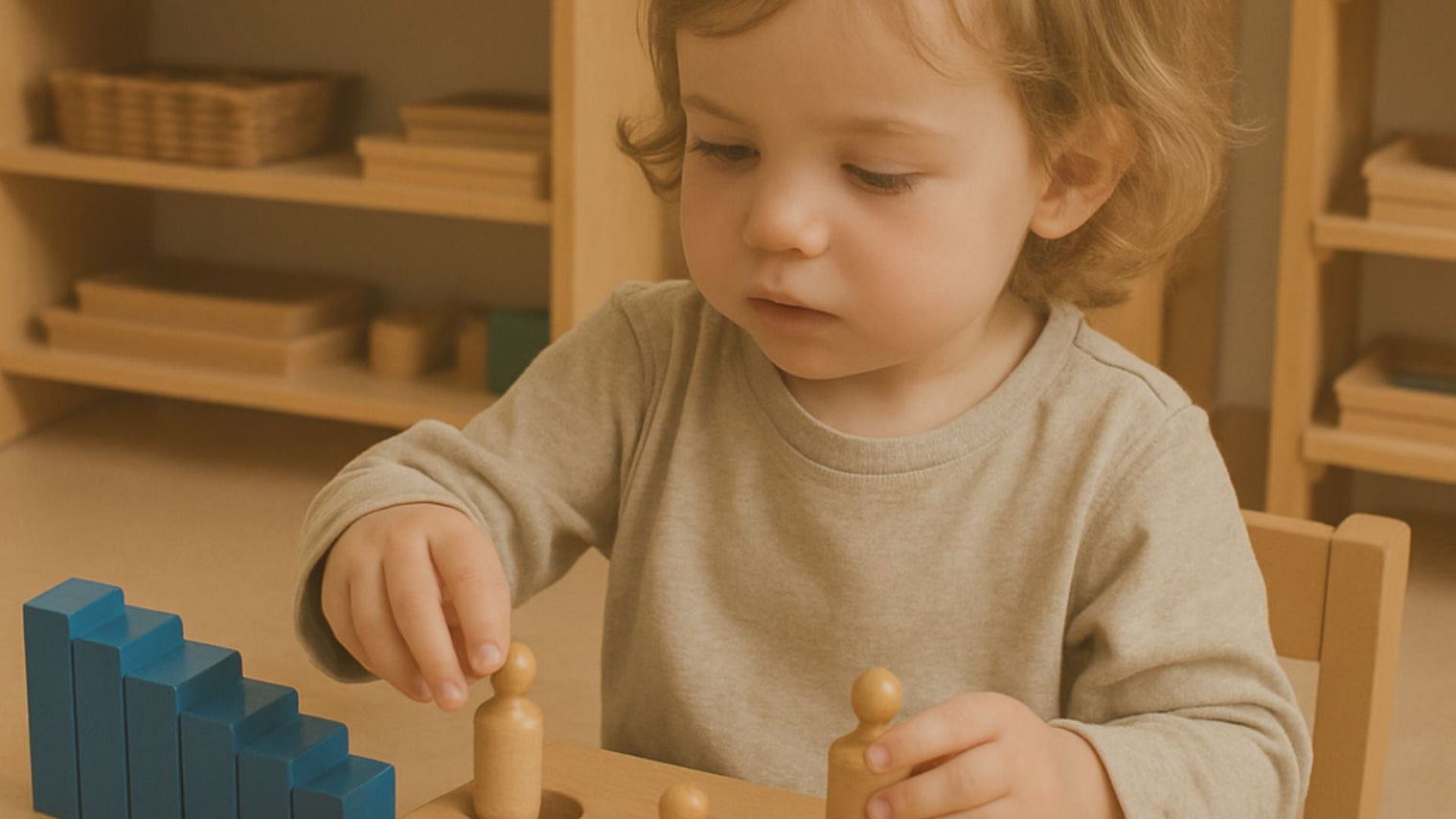Creating a Montessori-inspired space for your child doesn’t require a large house or a separate playroom.
In fact, some of the most effective Montessori environments are set up in small apartments, where thoughtful design and intentional choices make every inch count.
Why does this matter now?
More families are embracing Montessori at home because it encourages independence, creativity, and confidence in children.
And with apartment living becoming more common, parents often wonder if it’s possible to give their kids the benefits of Montessori in a limited space.
The good news: it absolutely is. With the right approach, you can design a cozy, functional Montessori space that supports your child’s growth without overwhelming your apartment.
Key Elements of a Montessori Space
- Child-Centered Design: Everything in the space should be accessible to the child. This means low shelves, child-sized furniture, and materials placed within reach. This setup encourages children to independently choose and engage with activities, fostering decision-making skills and confidence. By designing the space from a child's perspective, you respect their autonomy and create an environment where they feel valued and empowered.
- Simplicity and Order: A clutter-free space with organized materials helps children focus and engage more deeply with their activities. Clear organization allows children to know where each item belongs, promoting responsibility and care for their environment. Simplicity also reduces distractions, helping children to concentrate better and enjoy their activities more fully.
- Natural Materials: Using wood, cotton, and other natural materials provides a tactile experience that is both aesthetically pleasing and safe for children. Natural materials are often more durable and environmentally friendly, aligning with the Montessori values of sustainability and care for the planet. They also help in creating a warm and inviting atmosphere, conducive to learning and exploration.
Planning Your Montessori Space

Assess Your Space
Start by assessing the available space. Identify areas that can be transformed into a learning environment.
This could be a corner of a living room, a section of the child's bedroom, or even a small nook in the kitchen. Remember, the space doesn't need to be large; it just needs to be well-organized.
Consider factors like natural light, proximity to daily activities, and potential distractions when choosing the area.
Flexibility is key; be open to rearranging furniture or repurposing areas to create an ideal learning environment.
Define Zones
Divide the space into different zones based on activities. Common zones in a Montessori space include:
- Practical Life: This area includes activities that promote everyday skills like pouring, sweeping, and buttoning. These activities help children develop fine motor skills, hand-eye coordination, and a sense of responsibility. Incorporating real-life tools and materials empowers children to take part in daily household tasks.
- Sensorial: A space for activities that enhance sensory perception, such as color sorting or texture matching. Sensorial activities help children refine their senses and provide a foundation for learning in other areas, including math and language. These activities also encourage concentration and attention to detail.
- Language and Math: A zone with materials that encourage language development and mathematical thinking. Providing a variety of books, puzzles, and counting materials supports cognitive development and prepares children for academic success. Including interactive games and storytelling can make learning engaging and fun.
- Art and Creativity: An area with supplies for drawing, painting, and crafting. This zone nurtures creativity and self-expression, allowing children to explore their imaginations and develop fine motor skills. Encouraging artistic activities helps build problem-solving skills and fosters a lifelong appreciation for the arts.
Choosing the Right Furniture
Selecting the right furniture is essential to creating an effective Montessori space. Here are some tips to guide your selections and ensure that your space is both functional and inviting.
The right furniture can transform a small area into a dynamic learning environment that supports your child's growth and development.
Opt for Multi-Functional Furniture
In a small apartment, every piece of furniture should serve multiple purposes.
Consider a storage bench that doubles as seating, or a table with built-in storage for art supplies. This maximizes the use of space without compromising on function.
Multi-functional furniture can also adapt as your child's needs change, providing long-term value.
Look for pieces that are easy to move and reconfigure, allowing for flexibility as your child grows and their interests evolve.
Invest in Child-Sized Furniture
Child-sized tables and chairs are fundamental in a Montessori environment. They empower children to sit comfortably and work independently.
Look for pieces that are sturdy, safe, and made from natural materials. Investing in high-quality furniture ensures durability and safety, providing a stable foundation for learning.
Child-sized furniture also fosters a sense of ownership and encourages children to take pride in their space and belongings.
Use Open Shelving
Open shelving is a staple in Montessori spaces. It allows children to see all their materials, promoting independence and decision-making. Arrange materials in baskets or trays to keep the space organized and inviting.
Open shelves also make it easy to rotate materials, keeping the environment fresh and engaging.
By displaying materials clearly, you encourage children to explore and make choices independently, supporting their development as confident learners.
Selecting Montessori Materials
Choosing the right materials is crucial in a Montessori setup. Focus on quality over quantity to create an enriching environment that stimulates learning and creativity.
The materials you select should be engaging, purposeful, and aligned with Montessori principles.
Prioritize Quality
Invest in high-quality, durable materials that will stand the test of time.
Wooden toys, puzzles, and practical life tools are excellent choices. They should be simple, engaging, and purposeful.
Quality materials provide a rich sensory experience and support the development of fine motor skills.
By choosing materials that align with Montessori principles, you ensure that your child has access to meaningful and rewarding learning experiences.
Rotate Materials
To keep the environment fresh and engaging, rotate materials regularly.
This prevents overwhelm and keeps children curious and excited about their activities.
Rotating materials also allows you to introduce new challenges and interests as your child grows.
By regularly updating the available materials, you maintain a dynamic learning environment that adapts to your child's evolving needs and interests.
Creating a Montessori Atmosphere
The atmosphere of a Montessori space is as important as its physical setup.
Here are some ways to cultivate a nurturing environment that supports your child's growth and development.
A positive atmosphere encourages exploration, creativity, and a love for learning.
Encourage Independence
Design the space to encourage independence. This means placing hooks at child height for coats, using step stools for reaching sinks, and providing accessible storage for personal belongings.
By fostering independence, you help your child develop confidence and self-reliance.
Encouraging independence also allows children to take ownership of their learning and environment, promoting a sense of responsibility and agency.
Foster a Love of Nature
Bring elements of nature into the space. This could be a small plant, a window bird feeder, or nature-themed artwork.
These elements connect children to the natural world and promote a sense of calm. Incorporating nature into the learning environment also encourages curiosity and exploration, providing opportunities for children to learn about the world around them.
Nature-inspired activities can also foster environmental awareness and stewardship.
Maintain Simplicity and Order
A tidy and orderly space helps children concentrate and engage in their activities.
Encourage your child to return materials to their designated place after use, fostering responsibility and care for their environment.
Maintaining simplicity and order also creates a peaceful and inviting atmosphere, conducive to learning and exploration.
By modeling and encouraging these habits, you help your child develop important life skills and a sense of pride in their space.
Overcoming Common Challenges
Setting up a Montessori space in a small apartment comes with its challenges. Here's how to address some common ones and create a thriving learning environment despite space constraints.
By approaching challenges with creativity and flexibility, you can create a Montessori space that meets your child's needs and supports their development.
Limited Space
Get creative with vertical space. Use wall-mounted shelves or hanging organizers to maximize storage.
Additionally, consider foldable or collapsible furniture that can be tucked away when not in use.
Exploring these options allows you to make the most of every available inch, creating a functional and inviting space.
By thinking vertically, you can overcome space limitations and create a dynamic learning environment.
Budget Constraints
You don't need to buy everything at once. Start with the essentials and gradually expand your collection of Montessori materials.
DIY options or second-hand finds can also be a cost-effective way to furnish your space.
By prioritizing quality and creativity, you can create a rich learning environment without overspending.
Embrace resourcefulness and creativity to build a space that reflects Montessori values and supports your child's growth.
Adapting as Your Child Grows
A Montessori space is dynamic and should evolve with your child's interests and developmental needs.
Regularly update materials and furniture to keep the space engaging and appropriate for your child's age and abilities.
By remaining flexible and responsive, you can create a learning environment that continues to inspire and engage your child over time.
Embrace change and growth, allowing your Montessori space to evolve alongside your child.
FAQs
Do I need a separate room for a Montessori space?
No. A dedicated corner of your living room, bedroom, or even hallway is enough. What matters most is accessibility and consistency.
How do I keep the space from feeling cluttered?
Limit what’s on display to a handful of toys and rotate them regularly. Use storage bins for the rest.
What’s the best furniture for small apartments?
Look for compact, multi-purpose pieces—like low shelves, foldable tables, or storage benches. At Dannico Woodworks, we specialize in crafting space-efficient furniture that supports Montessori principles.
How do I make Montessori affordable?
Start with the basics: a small shelf, a child-sized table, and a few open-ended toys. DIY options can work, but investing in durable furniture ensures safety and longevity.
My apartment has limited natural light. What can I do?
Use warm, soft lamps and light-colored rugs to brighten the space. Mirrors can also reflect available light and make the area feel bigger.
Conclusion
Setting up a Montessori space in a small apartment is not only possible—it’s powerful. By focusing on simplicity, accessibility, and child-centered design, you can create an environment that encourages independence, confidence, and creativity.
At Dannico Woodworks, we understand the challenges of apartment living and design furniture that maximizes space while nurturing children’s growth.
Every piece is built to be safe, functional, and beautiful—so your child’s space feels just as special as they are.
So, what’s one small change you can make today to bring Montessori principles into your home?


